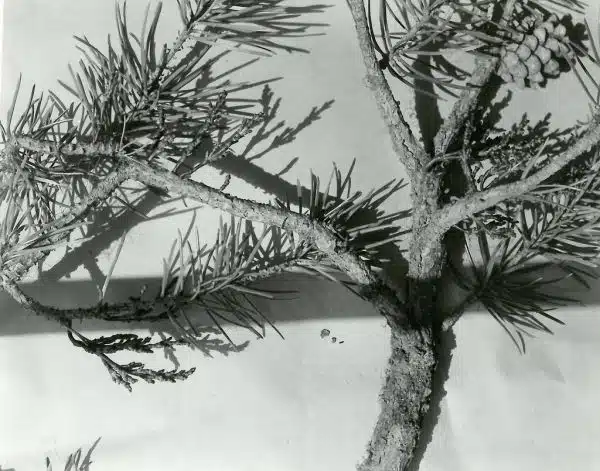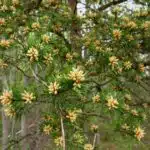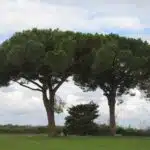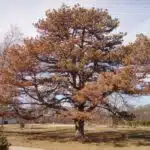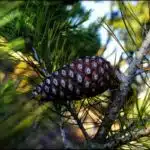Jack Pine trees are a popular choice for those looking to add some natural beauty to their property. With their unique appearance and ability to thrive in harsh conditions, they are a favorite among horticulture enthusiasts. However, growing and caring for these trees can be tricky, especially for beginners. In this article, we will explore the necessary steps for successfully growing and maintaining Jack Pine trees.
Firstly, it is important to understand the specific needs of Jack Pine trees. These trees require full sun exposure and well-draining soil. They also prefer cooler temperatures, making them a great option for those living in colder climates. Proper watering is crucial during the tree’s first year of growth, as they require consistent moisture until their roots establish themselves. Additionally, regular pruning is necessary to maintain its shape and promote healthy growth. By following these guidelines, you can ensure that your Jack Pine tree will flourish and provide you with years of natural beauty on your property.
Understanding The Characteristics Of Jack Pine Trees
Jack pine trees are a popular choice for landscaping, as they are known for their hardiness and adaptability. They are native to northern regions of North America and can grow up to 80 feet tall. The tree is characterized by its long needles, which can measure up to four inches in length, and its small cones that open when exposed to heat.
One of the unique characteristics of jack pine trees is their pinecone production. Unlike other types of pine trees, jack pines produce cones that remain closed until they are exposed to extreme heat, such as a forest fire. Once the cones open, the seeds inside are dispersed by the wind and can travel long distances. This adaptation allows jack pines to thrive in areas prone to wildfires.
When considering planting jack pines, it is important to choose the right location. These trees prefer well-drained soil and full sun exposure. They also require ample space to grow, as they can spread out up to 30 feet wide at maturity. Additionally, it is important to consider the potential for seed dispersal and ensure that planting does not interfere with nearby ecosystems or infrastructure.
Choosing The Right Location For Planting
Understanding the characteristics of Jack Pine Trees is crucial in determining the right location for planting. This species thrives in well-drained soils, with a pH range between 4.0 to 6.5. Jack Pine trees can also grow in sandy and rocky soils, making them suitable for planting on slopes, dunes, and ridges where other species may struggle to survive.
Soil quality plays a critical role in the growth of Jack Pine trees. The soil should be nutrient-rich, have good drainage and moisture retention capabilities. Before planting, it’s advisable to conduct a soil test to determine its pH level and nutrient content. If the soil is too acidic or lacks essential nutrients, it will need amendments before planting.
Sun exposure is another vital factor when choosing a location for planting Jack Pine trees. They require full sun exposure as they are not shade-tolerant. Therefore, select an area that receives at least six hours of direct sunlight daily to ensure optimal growth and development of your Jack Pine trees. In areas with hot summers, consider planting near water sources like rivers or lakes to provide some relief from heat stress during peak summer months.
Transition: Now that you have identified the right location for planting your Jack Pine trees based on their characteristics let’s move onto preparing the soil for planting.
Preparing The Soil For Planting
Preparing the soil for planting is crucial in ensuring the survival and growth of your jack pine trees. Soil preparation involves making sure that you have the right soil type, pH level, and nutrient composition. A good simile to describe this process is like preparing a canvas for painting; just as a painter prepares their canvas with a primer to ensure that the paint adheres well and lasts longer, so too must you prepare your soil for planting.
To start with, it is essential to conduct a nutrient test on your soil before planting. This will help determine whether any deficiencies or excesses exist in the soil. The results of the test will guide you in choosing the right fertilizer to add to your soil. Additionally, it will also inform you on how much lime or sulfur you need to adjust your pH levels.
Once you have determined what nutrients are lacking in your soil, it’s time to amend it accordingly. Adding organic matter such as compost or well-rotted manure can improve water retention and provide essential nutrients for plant growth. Tilling or digging into the ground about six inches deep helps loosen compacted soils and improves drainage. In summary, proper soil preparation is vital when growing healthy Jack Pine Trees.
Selecting The Right Time For Planting
After preparing the soil for planting, it is time to choose a nursery that offers high-quality jack pine seedlings. When selecting a nursery, it is important to ensure that they have a good reputation for producing healthy and vigorous trees. Look for a nursery that produces seedlings with well-developed root systems and straight stems. Generally, younger plants are preferred because they can adapt better to their new environment.
When planting the seedlings, it is crucial to ensure that they are planted at the right depth. Planting too deep can lead to poor growth or even death of the plant. On the other hand, planting too shallow may expose the roots and make them vulnerable to damage. The ideal planting depth for jack pine trees is about 1 inch below the collar (where the roots meet the stem). After planting, gently tamp down on the soil around the tree to remove any air pockets.
In summary, proper nursery selection and planting depth are essential for growing healthy jack pine trees. By choosing a reputable nursery and ensuring proper planting depth, you can give your young trees a good start in life. Next, we will discuss watering requirements for young trees – an important step in caring for your jack pine saplings as they establish themselves in their new home.
Watering Requirements For Young Trees
Watering is an essential factor in growing healthy jack pine trees. When young jack pines are planted, it is crucial to keep the soil moist for the first two years. The best way to achieve this is by providing consistent watering throughout the growing season, especially during hot and dry spells.
Mulching benefits can be significant for young jack pine trees as it helps to retain moisture in the soil, suppress weed growth, and regulate soil temperature. A layer of organic mulch around the base of the tree will also provide nutrients as it decomposes. However, care should be taken not to pile mulch against the trunk of the tree as this can lead to rotting and insect infestation.
Irrigation methods vary depending on your location and climate conditions. For those living in areas with low rainfall or frequent droughts, drip irrigation or a soaker hose may be necessary to ensure adequate moisture levels for young jack pine trees. It is essential not to overwater, as this can lead to waterlogging and root rot. A good rule of thumb is to water deeply once a week during dry periods, ensuring that the soil remains moist but not saturated.
To maintain healthy growth, fertilizing your jack pine tree is vital. In the next section, we will discuss how you can provide your tree with essential nutrients to encourage strong root development and vigorous growth.
Fertilizing Your Jack Pine Tree
Just as young trees require sufficient water to grow and thrive, they also need adequate nutrients to reach their full potential. Fertilizing your jack pine tree is an important step in ensuring its long-term health and vigor. However, it’s crucial to use the right type of fertilizer and apply it correctly to avoid overfertilization, which can harm your tree.
One of the best ways to fertilize your jack pine tree is by using organic fertilizers. These products are made from natural sources, such as composted manure or bone meal, and provide a slow-release source of nutrients that can feed your tree over time. Organic fertilizers are also less likely to burn your tree’s roots or cause imbalances in soil pH levels that can affect its growth.
When applying fertilizer to your jack pine tree, it’s important to follow the manufacturer’s instructions carefully. Overfertilization can lead to excessive growth, weak branches, and other issues that can compromise your tree’s health. To avoid this problem, be sure to measure out the correct amount of fertilizer based on the size of your tree and apply it evenly around the root zone. With proper fertilization techniques, you can help ensure that your jack pine tree grows strong and healthy for years to come.
As horticulture experts know well, proper fertilization is just one aspect of caring for a jack pine tree. Another important practice is pruning techniques for optimal growth. By removing dead or damaged branches and shaping the overall structure of your tree, you can promote better air circulation and light penetration throughout its canopy. In turn, this can help prevent disease and insect infestations while encouraging new growth and greater fruitfulness over time. So if you want a thriving jack pine tree in your yard or garden, be sure to consider both fertilization and pruning as part of your ongoing care routine.
Pruning Techniques For Optimal Growth
Pruning frequency is a critical factor in achieving optimal growth for jack pine trees. Pruning should be done on a regular basis to maximize the health of the tree and its foliage. Proper pruning techniques should be employed to ensure that the tree is not damaged in the process. It is recommended to use thinning pruning to selectively remove certain branches to encourage the growth of healthy buds and to reduce the risk of disease or insect infestation.
Pruning Frequency
Pruning is a vital component in the care and maintenance of jack pine trees. Proper pruning techniques can help to promote optimal growth, increase fruit production, and prevent disease or insect infestations. Pruning frequency, however, depends on several factors such as the age and size of the tree, its growth habit, and the desired shape.
Pruning should be done during the dormant season, which typically falls between late fall and early spring. Pruning tools such as hand pruners, loppers, or pruning saws should be sharp and sanitized before use to prevent damage or spread of diseases. Young jack pines may require more frequent pruning to establish their shape while mature trees will only need occasional pruning for maintenance purposes.
The frequency of pruning also depends on the growth habit of the tree. Jack pines with upright growth habits will require less pruning than those with a spreading habit. A spreading tree will need more frequent pruning to maintain its shape and avoid overcrowding. Overall, it is essential to employ proper pruning techniques when caring for jack pine trees as it can improve their aesthetic appeal and promote optimal growth.
Pruning Techniques
Pruning techniques are critical in ensuring optimal growth for jack pine trees. Proper techniques can improve the tree’s health, prevent diseases and pests, and increase fruit production. One essential aspect of pruning technique is understanding the branch structure of the tree. Jack pines have a unique branching pattern consisting of whorls of branches that originate from a central point on the stem. Understanding this structure is crucial in deciding which branches to remove or retain during pruning.
The timing of pruning is also important in achieving optimal growth for jack pine trees. As mentioned earlier, pruning should be done during the dormant season when the tree is not actively growing. Pruning during this period minimizes stress on the tree and reduces the risk of damage caused by weather conditions such as wind or frost. It also promotes faster healing of wounds resulting from pruning cuts, reducing the risk of disease or pest infestation.
There are different techniques employed in pruning jack pines depending on their age and growth habit. The most common technique involves removing dead, diseased, or damaged branches using sharp and sanitized tools such as hand pruners or saws. Younger trees may require regular heading back to promote lateral branching while mature trees may need thinning out to improve light penetration and air circulation within their canopy. It is essential to employ proper pruning techniques when caring for jack pines as it not only promotes optimal growth but also enhances their aesthetic appeal.
Dealing With Pests And Diseases
One of the most common issues that plague jack pine trees is insect infestation. The most damaging pests are the pine sawfly, jack pine budworm, and Zimmerman pine moth. These pests can lead to defoliation, stunted growth, and even death if left unchecked. Preventive measures such as proper pruning and thinning can help reduce the likelihood of infestation. Additionally, introducing natural predators like ladybugs or lacewings can help control the population of damaging insects.
Another issue to consider when caring for jack pine trees is disease. Needle cast disease and rust are two common diseases affecting this species. Needle cast disease causes needles to turn brown and fall off prematurely while rust causes yellow spots on needles with eventual needle loss. Proper pruning practices can help reduce the spread of these diseases by promoting airflow throughout the tree canopy. Using natural remedies such as neem oil or copper fungicide can also help combat these diseases.
If you notice any signs of pest or disease on your jack pine tree, it is important to act quickly to prevent further damage. Regular inspection of your tree can help catch any problems early on before they become too severe. Remember that prevention through proper care practices is key in keeping your tree healthy and thriving for years to come.
Transition: Now that you know how to prevent and treat pest and disease issues with your jack pine tree, it’s time to prepare it for winter by following some simple steps.
Winterizing Your Jack Pine Tree
As the saying goes, “an ounce of prevention is worth a pound of cure.” This sentiment holds true when it comes to winterizing your jack pine tree. Protecting roots is a crucial step in ensuring that your tree can withstand harsh winter conditions. To do this, it is recommended to apply a layer of mulch around the base of the tree. This will insulate the roots and help retain moisture during dry spells.
Winter watering is another key component in maintaining the health of your jack pine tree. It is important to keep the soil moist, but not waterlogged, throughout the winter months. This can be achieved by watering deeply once a month if there has been little precipitation or if temperatures are above freezing. Be sure to avoid watering when temperatures are below freezing as this can cause damage to both the roots and trunk.
In addition to mulching techniques and winter watering, frost protection is also necessary for your jack pine tree’s survival. Covering your tree with burlap or other protective material can prevent frost damage to delicate branches and foliage. Be sure to remove any covering once temperatures rise above freezing to prevent overheating and encourage healthy growth come springtime. By following these steps, you can ensure that your jack pine tree will thrive throughout even the harshest winter conditions.
As you prepare for enjoying the beauty of your jack pine tree in all its splendor come springtime, there are a few final steps you should take. Removing any dead or damaged branches before new growth begins will promote healthy growth and improve visual appeal. Additionally, pruning young trees regularly will help shape them as they grow into mature trees. By taking these simple steps now, you can sit back and enjoy the beauty of your jack pine tree for years to come.
Enjoying The Beauty Of Your Jack Pine Tree
Once your jack pine tree has matured and established itself in your yard, you can begin to appreciate its beauty. One way to do this is by photographing its unique branches. Jack pine trees have a distinct shape with twisted and crooked branches that create a striking visual contrast against the sky. Capturing this contrast can make for beautiful photos that showcase the tree’s unique characteristics.
Another way to enjoy the beauty of your jack pine tree is by incorporating natural elements into home decor. Pinecones are a classic decoration that can add rustic charm to any space. Collecting fallen pinecones from your tree and using them in wreaths, centerpieces, or other crafts is not only aesthetically pleasing but also sustainable. This way, you can enjoy the beauty of your jack pine tree even when you’re indoors.
In addition to admiring its physical attributes, taking care of your jack pine tree also ensures its continued beauty over time. Proper pruning and maintenance will keep it healthy and looking its best for years to come. With these simple steps and creative ideas, you can fully appreciate the beauty of your jack pine tree while at the same time serving as a responsible caretaker for this magnificent plant species.
- Decorating with Pinecones:
- Collecting fallen pinecones from your Jack Pine Tree
- Using them in wreaths, centerpieces or other crafts
Overall, taking care of and appreciating the beauty of your Jack Pine Tree is an enjoyable experience that offers many rewards. By capturing photographs of its unique features and incorporating natural elements like pinecones into home decor, you can showcase the grandeur of this majestic tree species. Remember to always maintain proper care practices so that future generations may also enjoy its splendor for years to come!
Conclusion
In conclusion, growing and caring for jack pine trees can be a fulfilling experience for any horticulture enthusiast. With their unique characteristics and aesthetic appeal, these trees are a great addition to any landscape. By understanding the specific needs of jack pine trees, selecting the right location, preparing the soil for planting, watering and pruning techniques, managing pests and diseases, winterizing your tree and enjoying its beauty, you can ensure optimal growth and long-term health of your tree.
The beauty of jack pine trees cannot be overstated. Their charming appearance adds an enchanting touch to any garden or park. With proper care and maintenance, they can thrive in any environment. Whether you are looking to add some greenery to your backyard or create an outdoor oasis for relaxation, planting a jack pine tree is the perfect choice. So don’t hesitate to try your hand at growing these spectacular trees – you’ll be rewarded with abundant beauty and joy!
Image Credits

